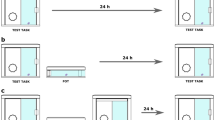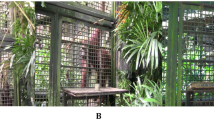Abstract
Planning for future needs has traditionally been considered to be restricted to human cognition. Although recent studies on great ape and corvid cognition challenge this belief, the phylogenesis of human planning remains largely unknown. The complex skill for future planning has not yet been satisfactorily established in any other extant primate species than our own. In humans, planning for future needs rely heavily on two overarching capacities, both of which lie at the heart of our cognition: self-control, often defined as the suppression of immediate drives in favor of delayed rewards, and mental time travel, which could be described as a detached mental experience of a past or future event. Future planning is linked to additional high complexity cognition such as metacognition and a consciousness usually not attributed to animals. In a series of four experiments based on tool use, we demonstrate that chimpanzees (Pan troglodytes) and orangutans (Pongo abelii) override immediate drives in favor of future needs, and they do not merely rely on associative learning or semantic prospection when confronted with a planning task. These results suggest that great apes engage in planning for the future by out competing current drives and mentally pre-experiencing an upcoming event. This suggests that the advanced mental capacities utilized in human future planning are shared by phylogenetically more ancient species than previously believed.

Similar content being viewed by others
References
Ainslie G (1974) Impulse control in pigeons. J Exp Anal Behav 21:485–489
Ainslie G (2001) Breakdown of Will. Cambridge University Press, Cambridge
Ainslie G (2007) Foresight has to pay off in the present moment. Behav Brain Sci 30:313–314
Andreasen NC, O’Leary DS, Cizadlo T, Arndt S, Rezai K, Watkins GL, Ponto LL, Hichwa RD (1995) Remembering the past: two facets of episodic memory explored with positron emission tomography. Am J Psychiatry 152:1576–1585
Atance CM, Meltzoff AN (2007) How developmental science contributes to theories of future thinking. Behav Brain Sci 30:314–315
Atance CM, O’Neill DK (2001) Episdodic future thinking. Trends Cognit Sci 5:533–539
Atance CM, O’Neill DK (2005) The emergence of episodic future thinking in humans. Learn Motiv 36:126–144
Beran MJ, Evans TA (2006) Maintenance of delay of gratification by four chimpanzees (Pan troglodytes). Behav Process 73:315–324
Beran MJ, Savage-Rumbaugh ES, Pate JL, Rumbaugh DM (1999) Delay of gratification in chimpanzees (Pan troglodytes). Dev Psychobiol 34:119–127
Boesch C, Boesch-Acherman H (2000) The Chimpanzees of the Taï Forest: behavioural ecology and evolution. Oxford University Press, Oxford
Bolles RC (1970) Species-specific defence reactions and avoidance learning. Psych Rev 77:32–48
Buckner RL, Carroll DC (2007) Self-projection and the brain. Trends Cognit Sci 11:49–57
Byrne R (1995) The thinking ape: evolutionary origins of intelligence. Oxford University Press, Oxford
Call J (2006) Descartes’ two errors: reason and reflection in the great apes. In: Hurley S, Nudds M (eds) Rational animals. Oxford University Press, Oxford, pp 219–234
Carlson SM, Moses LJ (2001) Individual differences in inhibitory control and children’s theory of mind. Child Dev 72:1032–1053
Christoff K, Ream JM, Gabrieli JDE (2004) Neural basis of spontaneous thought processes. Cortex 40:623–630
Clayton NS, Dickinson A (1998) Episodic-like memory during cache recovery by scrub jays. Nature 395:272–274
Clayton NS, Dickinson A (1999) Scrub jays (Aphelocoma coerulescens) remember the relative time of cahing as well as the ___location and content of their caches. J Comp Psychol 113:403–416
Correia SPC, Dickinson A, Clayton NS (2007) Western scrub-jays anticipate future needs independently of their current motivational state. Curr Biol 17:856–861
de Waal FBM (1982) Chimpanzee politics: power and sex among apes. Jonathan Cape, London
Duckworth AL, Seligman MEP (2005) Self-discipline outdoes IQ in predicting academic performance of adolescents. Psychol Sci 16:939–944
Emery NJ (2006) Cognitive ornithology: the evolution of avian intelligence. Philos Trans R Soc B 361:23–43
Evans TA, Beran MJ (2007) Chimpanzees use self-distraction to cope with impulsivity. Biol Lett, doi: 10.1098/rsbl.2007.0399
Forzano LB, Logue AW (1992) Predictors of adult humans’ self-control and impulsiveness for food reinforcers. Appetite 19:33–47
Fredrick S, Loewenstein G, O’Donoghue T (2002) Time discounting: a critical review. J Econ Lit 40:351–401
Gardiner JM (2002) Episodic memory and autonoetic consciousness: a first person approach. In: Baddeley A, Conway M, Aggleton J (eds) Episodic memory–new directions in research. Oxford University Press, Oxford, pp 11–30
Gilbert DT, Wilson TD (2007) Prospection: Experiencing the future. Science 317:1351–1354
Gulz A (1991) The planning of action as a cognitive and biological phenomenon. Lund Univ Cognit Stud 2:1–187
Ingvar DH (1979) “Hyperfrontal” distribution of the cerebral grey matter flow in resting wakefulness: on the functional anatomy of the conscious state. Acta Neurol Scand 60:12–25
Köhler W (1921) Zur psychologie des schimpansen. Psychol Forsch 1:2–46
Köhler W (1925) The mentality of apes. Penguin Books, London
Maslow AH (1943) A theory of human motivation. Psych Rev 50:370–396
Macphail EM (1998) The evolution of consciousness. Oxford University Press, New York
Mischel W, Shoda Y, Rodriguez M (1989) Delay of gratification in children. Science 244:933–938
Mulcahy NJ, Call J (2006) Apes save tool for future use. Science 312:1038–1040
Mulcahy NJ, Call J, Dunbar R (2005) Gorillas (Gorilla gorilla) and orangutans (Pongo pygmaeus) encode relevant problem features in a tool-using task. J Comp Psychol 119:23–32
Naqshbandi M, Roberts WA (2006) Anticipation of future events in squirrel monkeys (Saimiri sciureus) and rats (Rattus norvegicus): Test of the Bischof-Kohler hypothesis. J Comp Psychol 120:345–357
Noble W, Davidson I (1996) Human evolution, language and mind: a psychological and archaeological inquiry. Cambridge University Press, Melbourne
O’Doherty J, Rolls ET, Francis S, Bowtell R, McGlone F, Kobal G, Renner B, Ahne G (2000) Senosory-specific satiety-related olfactory activation of the human orbitofrontal cortex. Neuroreport 11:399–403
Osvath M, Gärdenfors P (2005) Oldowan culture and the evolution of anticipatory cognition. Lund Univ Cognit Stud 122:1–16
Premack D (2007) Humans and animal cognition: continuity and discontinuity. Proc Natl Acad Sci USA 104:13861–13867
Raby CR, Alexis DM, Dickinson A, Clayton NS (2007) Planning for the future by western scrub-jays. Nature 445:919–921
Ramseyer A, Pelé M, Dufour V, Chauvin C, Thierry B (2006) Accepting loss: the temporal limits of reciprocity in brown capuchin monkeys. Proc R Soc B 273:179–184
Rilling JK, Barks SK, Parr LA, Preuss TM, Faber TL, Pagnoni G, Bremner JD, Votaw JR (2007) A comparison of resting-state brain activity in humans and chimpanzees. Proc Natl Acad Sci USA 104:17146–17151
Roberts WA (2002) Are animals stuck in time? Psych Bull 128:473–489
Roberts WA (2006) The questions of temporal and spatial displacement in animal cognition. In: Wasserman EA, Zentall TR (eds) Comparative cognition: experimental explorations of animal intelligence. Oxford University Press, New York, pp 145–63
Rosati AG, Stevens JR, Hare B, Hauser MD (2007) The evolutionary origins of human patience: temporal preferences in chimpanzees, bonobos, and human adults. Curr Biol 17:1663–1668
Schwartz BL, Hoffman ML, Evans S (2005) Episodic-like memory in a gorilla: a review and new findings. Learn Motiv 36:226–244
Seligman MEP (1970) On the generality of the laws of learning. Psych Rev 77:406–418
Shettleworth SJ (2007) Planning for breakfast. Nature 445:825–826
Small DM, Zatorre RJ, Dagher A, Evans AC, Jones-Gotman M (2001) Changes in brain activity related to eating chocolate: from pleasure to aversion. Brain 124:1720–1733
Stevens J, Rosati A, Ross K, Hauser M (2005) Will travel for food: spatial discounting in two new world monkeys. Curr Biol 15:1855–1860
Suddendorf T (2006) Foresight and evolution of the human mind. Science 312:1006–1007
Suddendorf T, Busby J (2005) Making decisions with the future in mind. Learn Motiv 36:110–125
Suddendorf T, Corballis MC (1997) Mental time travel and the evolution of the human mind. Genet Soc Gen Psychol Monogr 123:133–167
Suddendorf T, Corballis MC (2007) The evolution of foresight: what is mental time travel and is it unique to humans? Behav Brain Sci 30:299–351
Suddendorf T, Corballis MC (2008). New evidence for animal foresight? Anim Behav. doi:10.1016/j.anbehav.2008.01.006
Szpunar KK, Watson JM, McDermott KB (2007) Neural substrates of envisioning the future. Proc Natl Acad Sci USA 104:642–647
Tangney JP, Baumeister RF, Boone AL (2004) High self-control predicts good adjustment, less pathology, better grades and interpersonal success. J Pers 72:271–324
Tobin H, Logue A (1994) Self-control across species. J Comp Psychol 108:126–133
Tulving E (1972) Episodic and semantic memory. In: Tulving E, Donaldson W (eds) Organization of memory. New York Academic Press, New York, pp 381–403
Tulving E (2005) Episodic memory and autonoesis: uniquely human? In: Terrace H, Metcalfe J (eds) The missing link in cognition: evolution of self-knowing consciousness. Oxford University Press, New York, pp 3–56
Acknowledgments
We would like to thank the members of the LUCS-seminar and Josep Call, Frans de Waal, Daniel Haun, Tomas Persson, Endel Tulving and Staffan Ulfstrand. We are especially grateful to Ing-Marie Persson at Furuvik Zoo.
Author information
Authors and Affiliations
Corresponding author
Rights and permissions
About this article
Cite this article
Osvath, M., Osvath, H. Chimpanzee (Pan troglodytes) and orangutan (Pongo abelii) forethought: self-control and pre-experience in the face of future tool use. Anim Cogn 11, 661–674 (2008). https://doi.org/10.1007/s10071-008-0157-0
Received:
Revised:
Accepted:
Published:
Issue Date:
DOI: https://doi.org/10.1007/s10071-008-0157-0




